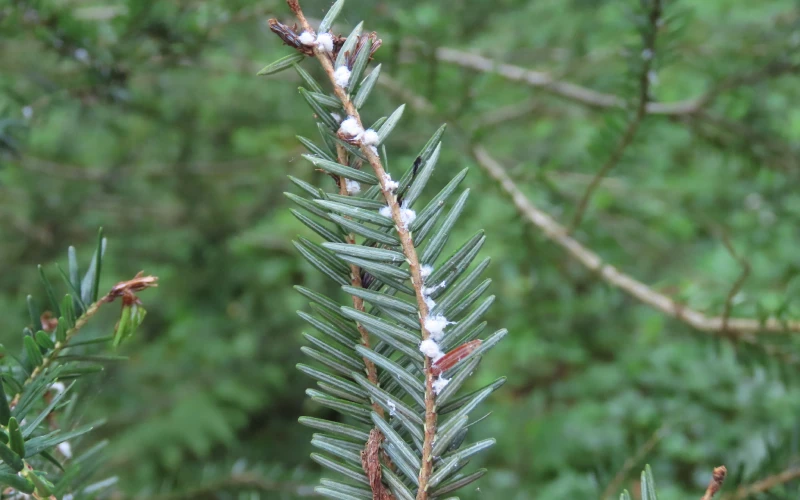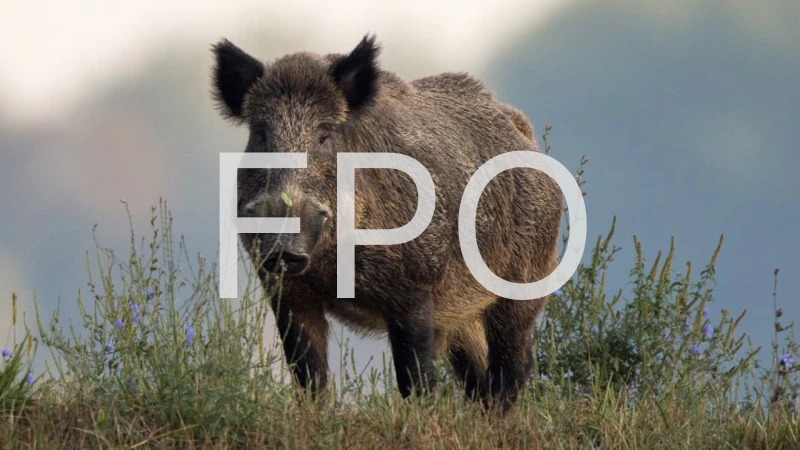Hemlock Woolly Adelgid
Description
The Hemlock Woolly Adelgid (HWA) is an aphid-like insect that feeds on the sap of hemlock trees, causing significant damage and often resulting in tree death. It is identifiable by the white, woolly egg sacs it produces, which resemble cotton balls or clumps of snow located at the base of the needles on hemlock trees.

© Chuck Cantley via iNaturalist.org, used under CC BY NC
Background
First identified in Virginia, USA, in 1951, HWA is believed to have originated from infested nursery stock from Japan. It has spread extensively in the eastern United States and parts of Canada. While native to Asia, HWA has natural enemies in its original habitat that control its population. However, in eastern North America, the lack of these natural predators has led to uncontrolled population growth and significant damage to hemlock forests.[1]
Hosts
HWA attacks various species of hemlock trees however they have the greatest impact on Eastern (Tsuga canadensis) and Carolina hemlocks (T. caroliniana) of eastern North America. It poses a significant threat to these trees across their ranges in both the United States and Canada.
Distribution
The adelgid is found in parts of Asia, and many states in the USA, including Alaska, California, Connecticut, and other states along the East coast. In Canada, HWA has been found in British Columbia, Nova Scotia (2017) and Ontario (2012), though the detections in Ontario were eradicated and continue to be monitored.
It should be noted that the western version of the hemlock woolly adelgid represents a distinct genetic branch from its eastern counterpart, suggesting it is native to the region rather than being an introduced species. There is concern among western foresters about the possibility of the eastern adelgid biotype spreading to the western region, due to uncertainties regarding the potential severity of tree death.
Biology
HWA reproduces asexually in North America, with two generations per year. The lifecycle includes dormant stages and periods of rapid population growth facilitated by egg production. The lack of a viable winged generation restricts natural long-distance movement, relying instead on wind, animals, or human activity for spread [2].
Detection & Identification
Signs of HWA infestation include white woolly sacs on hemlock twigs, premature needle loss, thinning crowns, and eventual tree death. Identification involves spotting the distinctive egg sacs using traps and modified slingshots, as well as observing damage symptoms on the trees.
The symptoms of infested trees include:
Life Stages for Identification
Simplified life cycle of hemlock woolly adelgid. HWA in Canada only go through a partial life cycle compared to populations in Japan, where this invasive insect originated. (Illustration by N. P. Havill and V. D’Amico)

Egg Stage

Nymph Stage

Adult Stage
Consequences
In affected areas, particularly in the United States, HWA has caused widespread hemlock forest loss, impacting wildlife habitat, water and nutrient cycling, and increasing erosion ratesOn Canada’s East coast, HWA risks to hemlock threatens the traditional ecological knowledge of the Wabanaki Peoples about the tree’s medicinal, ceremonial and cultural significance.
The economic, cultural and ecological impacts of HWA has mobilized a concerted effort for management and control.
Management and Future Prospects
Management efforts include regulatory measures to prevent the spread, biological control research, and chemical treatments. Releases of predatory beetles such as Laricobius nigrinus, which is native to the Pacific Northwest, that feeds exclusively on adelgids [3] and integrated pest management strategies offer hope for controlling HWA populations and preserving hemlock forests.
Collaboration and Research
Ongoing research and collaboration among government agencies, non-profit organizations, and community groups aim to improve detection methods, understand the pest’s biology, and develop effective control measures. Citizen science and reporting are encouraged to assist in these efforts.
What You Can Do:
You can prevent the spread of hemlock woolly adelgid by:
If you do have an infestation:
Remember to Buy Local Burn Local to protect natural habitats and biodiversity by stopping the spread of invasive species.
Report any potential sightings of the Hemlock Woolly Adelgid to your local invasive species council, CFIA or through the iNaturalist website.
For more information and resources on Hemlock Woolly Adelgid, visit:
Canadian Food Inspection Agency Fact Sheet
https://inspection.canada.ca/plant-health/invasive-species/insects/hemlock-woolly-adelgid/fact-sheet/eng/1325616708296/1325618964954
Nova Scotia Hemlock Woolly Adelgid Information
Nova Scotia Invasive Species Council
https://nsinvasives.ca/hemlock-woolly-adelgid/#:~:text=Hemlock%20Woolly%20Adelgid%20is%20an,are%20present%20March%20to%20June.
Ontario Hemlock Woolly Adelgid Information
https://www.ontario.ca/page/hemlock-woolly-adelgid
1.P McCarty, Elizabeth, and Karla M Addesso. “Hemlock Woolly Adelgid (Hemiptera: Adelgidae) Management in Forest, Landscape, and Nursery Production.” Journal of insect science (Online) vol. 19,2 (2019): iez031. doi:10.1093/jisesa/iez031
2. S Limbu, M A Keena, M C Whitmore, Hemlock Woolly Adelgid (Hemiptera: Adelgidae): A Non-Native Pest of Hemlocks in Eastern North America, Journal of Integrated Pest Management, Volume 9, Issue 1, 2018, 27, https://doi.org/10.1093/jipm/pmy018
3. Onken, B.; Reardon, R. 2011. Implementation and status of biological control of the hemlock woolly adelgid. US Department of Agriculture, US Forest Service, Forest Health Technology Enterprise Team, Technology Transfer, FHTET-2011-04(December). Available from: https://www.fs.usda.gov/naspf/publications/implementation-and-status-biological-control-hemlockwoolly-adelgid.